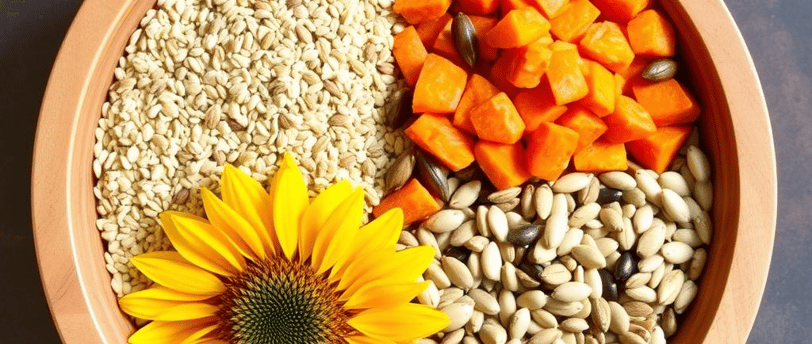Try Seed Cycling for Menstrual Health: A Natural Approach to Balance Your Hormones
🧘WELLNESS TIPS🌸 HORMONAL BALANCE & WOMEN’S WELLNESS


In the quest for optimal menstrual health and hormonal balance, many women are turning to holistic methods that emphasize nutrition and natural remedies. One such approach gaining popularity is seed cycling—a simple, yet powerful dietary strategy that leverages the nutritional benefits of seeds to help regulate and synchronize hormonal fluctuations throughout the menstrual cycle. This article explores the principles of seed cycling, backed by scientific evidence, and provides practical tips for incorporating flaxseeds, pumpkin seeds, sunflower seeds, and sesame seeds into your diet for better menstrual health.
Understanding Seed Cycling
Seed cycling involves consuming specific types of seeds during different phases of the menstrual cycle to support hormonal balance. The menstrual cycle is typically divided into two main phases: the follicular phase (days 1 to 14) and the luteal phase (days 15 to 28). Each phase is characterized by a unique hormonal profile dominated by estradiol and progesterone, which play crucial roles in regulating the menstrual cycle and overall reproductive health.
Follicular Phase: Flaxseeds and Pumpkin Seeds
During the follicular phase, estrogen levels begin to rise, promoting the growth and maturation of ovarian follicles. To support this process, it is recommended to consume flaxseeds and pumpkin seeds.
Flaxseeds: Renowned for their high content of omega-3 fatty acids and lignans, flaxseeds have been shown to help regulate estrogen levels. Lignans, in particular, are phytoestrogens that can bind to estrogen receptors in the body, potentially alleviating symptoms of estrogen dominance. A study published in the Journal of Clinical Endocrinology and Metabolism highlights how flaxseed supplementation can lead to a better balance of estrogen levels in premenopausal women.
Pumpkin Seeds: Full of essential nutrients like magnesium, zinc, and omega-6 fatty acids, pumpkin seeds help support hormonal regulation and provide vital support for the menstrual cycle. Magnesium, in particular, is known for its role in reducing PMS symptoms and promoting relaxation. A study in the Journal of Women's Health suggests that magnesium supplementation may have positive effects on premenstrual syndrome, reducing symptoms such as mood swings and cramps.
Luteal Phase: Sunflower Seeds and Sesame Seeds
In the luteal phase, progesterone levels increase to prepare the body for potential pregnancy. To support this phase, incorporating sunflower seeds and sesame seeds into your diet is recommended.
Sunflower Seeds: Rich in vitamin E, selenium, and essential fatty acids, sunflower seeds are thought to support progesterone production and overall hormonal health. A study published in the Journal of Reproductive Medicine found that women with adequate vitamin E intake experienced fewer menstrual problems, including reduced cramps and mood fluctuations.
Sesame Seeds: These tiny seeds pack a potent nutritional punch, containing high levels of phytoestrogens, zinc, and healthy fats. Zinc is crucial for balancing hormones and supporting healthy ovulation, while the lignans in sesame seeds may help modulate estrogen levels. Research published in Nutrition and Cancer indicates that sesame seeds have been linked to favorable hormonal changes in premenopausal women when included as part of a balanced diet.
How to Practice Seed Cycling
Incorporating seed cycling into your routine is straightforward and can easily be adjusted to suit your personal dietary preferences. Here’s a simple guide:
First Half of Your Cycle (Days 1 to 14)
Flaxseeds: Consume 1-2 tablespoons of ground flaxseeds daily. You can add them to smoothies, yogurt, or oatmeal for a nutritious boost.
Pumpkin Seeds: Add 1-2 tablespoons of raw or roasted pumpkin seeds to salads, soups, or trail mixes for an added crunch.
Second Half of Your Cycle (Days 15 to 28)
Sunflower Seeds: Incorporate 1-2 tablespoons of sunflower seeds into your snacks or salads to provide a nourishing, crunchy texture.
Sesame Seeds: Use 1-2 tablespoons of sesame seeds in various dishes or use tahini (ground sesame seeds) as a spread or dressing.
Additional Tips for Success
Stay Consistent: Aim to stick to the seed cycling plan for a minimum of three months to evaluate the potential benefits. Hormonal balance takes time, and consistency can yield more pronounced effects.
Pair with a Balanced Diet: While seed cycling can be beneficial, it’s essential to incorporate a well-rounded diet rich in whole foods, fruits, vegetables, and lean proteins to support overall health.
Listen to Your Body: Pay attention to how you feel as you implement this practice. Hormonal health can be complex, and personal experiences may vary.
Consult a Healthcare Professional: Before starting any nutritional regimen, especially if you have underlying health conditions or are on medication, it’s wise to consult with a healthcare provider or a registered dietitian for personalized guidance.
Conclusion
In summary, seed cycling is a natural, evidence-based approach to enhance menstrual health by leveraging the nutritional components of flaxseeds, pumpkin seeds, sunflower seeds, and sesame seeds across the different phases of the menstrual cycle. With growing scientific evidence supporting these nutritional interventions, incorporating these seeds into your diet could serve as a simple yet effective strategy for hormonal balance.
Make the switch today, and take a proactive step toward better menstrual health. By choosing to nourish your body with these nutrient-dense seeds, you may find relief from various menstrual symptoms and promote overall hormonal harmony. So grab a bag of seeds, get creative in the kitchen, and embrace the journey toward vibrant menstrual health.
